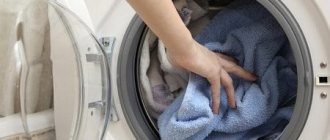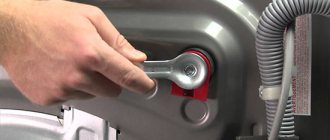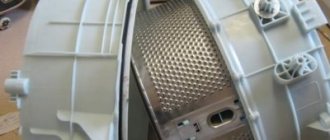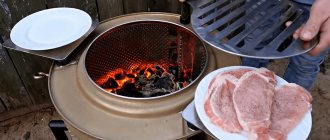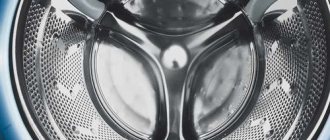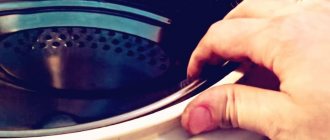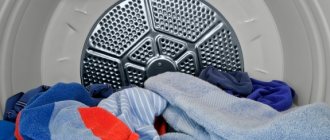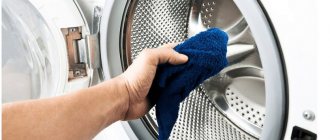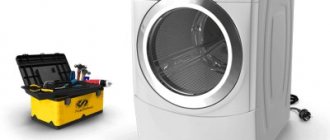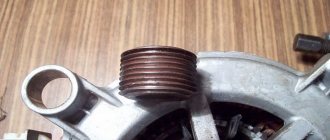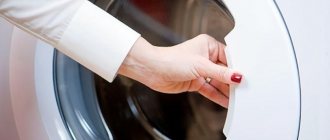Good afternoon. Let's take a closer look at the operation of the Samsung WD806U2 washing machine. We have already devoted our review to the advantages of this unit, now we will study management and maintenance. Let's start traditionally with the detergent compartment. Add pre-wash detergent to the first compartment. With a flower, this is a compartment for conditioner and similar additives. The main thing here is not to overdo it and not exceed the maximum level. Please note that these additives will enter the drum during rinsing and only during rinsing. Finally, the second compartment is for the main detergent. Don't get confused. After all, each department works according to its own program. The compartment can be removed simply - press the tab and take it out. Do not forget, at least sometimes, to wash the compartment itself and the space behind it. At the same time, check the cleanliness of the door seal.
Balancing the washing machine drum: instructions
Have you noticed that your washing machine has started to make a loud noise and jump during the spin cycle?
Perhaps the reason is that the drum is unbalanced. If you have such a problem, you need to solve it, because excessive noise and vibration not only disturb you, but also lead to wear on the parts of the washing machine. In earlier models, the imbalance leads to strong vibrations during the spin cycle. And modern models can stop if the system fails to restore balance.
Why does the drum become unbalanced?
The drum becomes unbalanced during spinning. The laundry bunches up into one lump, causing an imbalance and causing the machine to shake violently. Below are the main reasons why imbalance occurs:
- When washing bedding, smaller items could get caught in the duvet cover. The result was a large piece of underwear.
- There is too much or too little laundry in the drum.
- Washing at temperatures above 60 degrees is accompanied by additional water intake during rinsing. This may lead to a slight imbalance. Pay attention to this when choosing the water temperature.
- Mechanical problems can also be a culprit. Worn bearings or a rusty, bent shaft lead to increased vibration, and spinning may not occur at all.
Some washing machine models display an error code on the display, which indicates an imbalance.
How to balance a drum with your own hands
Washing machine drum balancing is automatically built into modern models from Samsung, LG, Bosch, and Ardo. This additional feature is called "Imbalance Control". In this case, the system will not allow the washing machine to spin until the problem is resolved. To do this, the drum rotates in different directions, sometimes slowing down, sometimes accelerating.
If you set the spin to maximum speed, but the imbalance is not corrected, then the machine will significantly reduce the spin speed so as not to harm its parts. Or the spin cycle will be stopped altogether. In any case, you will get almost wet laundry out of the drum.
How to do balancing yourself? Proceed sequentially:
Top-loading washers make it easier to center laundry because you don't have to drain the water to open the door. If, after distributing the items, the washer shakes again during the spin cycle, check the balancing stones. They are located behind the front and rear panels of the SMA and are attached to the drum. Sometimes their fastenings become loose, leading to imbalance.
How to adjust the legs of a washing machine | | DIY repair
Furniture supports are often purchased by hotels to complement existing furniture. This is usually done when the modification is made for the purpose of:
- implementation of the possibility of adjusting the height of furniture;
- to increase product mobility;
- to change the design by replacing ordinary legs with decorative ones.
When choosing a specific support element design, you should pay attention to the following characteristics:
- ergonomics and practicality of the product, ensuring maximum ease of use;
- ability to perform assigned functions;
- ability to bear the required weight loads;
- decorativeness and style of the product.
From the video you will learn about all types of furniture supports, features of their fastening and application.
Typically, renovations in the bathroom, and sometimes in the kitchen, include the installation of a washing machine. These are, so to speak, typical places for placing this device in standard apartments. Although the ideal place for a washing machine is somewhere in the basement, if its owner is the owner of a large house with a well-equipped basement. But this is not the point, but the question: “how to install a washing machine correctly?”
The main task when installing a washing machine is to achieve the maximum permissible absence of any vibrations during its operation. This will guarantee its long service life, the absence of unpleasant noises and the elimination of possible displacement from the installation site. Among other things, the manufacturer requires correct installation from the consumer; these requirements are set out in the operating instructions for the washing machine.
Of course, a lot will depend on the washing machine itself, on the quality of its build, on the manufacturer, on its design. It is worth noting that when installed correctly, washing machines with direct drive vibrate significantly less during operation than washing machines that do not have direct drive, also installed according to all the rules. In a nutshell, direct drive (see Direct Drive) is a device for washing machine mechanisms in which the drum of the machine is driven directly by the motor shaft without any kind of transmission links, such as, for example, a belt drive. “Extra” nodes add extra vibrations. But many manufacturers today have learned to solve problems associated with indirect drive devices, minimizing the impact of this factor as much as possible. In addition to the drive device, top-loading washing machines can be considered structurally less vibrating machines. In top-loading washing machines, unlike the more common side-loading machines, the washing drum has an additional hinge point, which significantly reduces vibration when the drum rotates.
How to avoid imbalance
Make sure that you load the drum according to the norm for your washing machine. If the washing machine is designed for three kilograms of laundry, this does not mean that you need to fill the drum to capacity. It should be 2/3 full. And:
If you are just going to buy a washing machine, choose the load capacity in accordance with the number of everyday items to wash. If, when choosing a drum volume of 7-8 kg, you cannot collect enough for a daily load, washing once a week will not always be convenient.
Source
The washing machine jumps during the spin cycle: causes and remedies
Question: Why does the washing machine jump during the spin cycle and constantly move? What could be the reasons?
The washing machine jumps during the spin cycle - this is due to destabilization during operation (washing clothes) or an unstable floor surface. Also, if there is vibration, you should check for defects - the drum, shock absorbers and bearings. Place on a hard, level surface.
Instructions: what to do if the washing machine jumps during the spin cycle:
- The legs may not be adjusted : The legs of the washing machine should be adjusted to the building level.
- Transport bolts not removed : Make sure there are no transport bolts.
- Shock absorbers are faulty : Check the condition of the shock absorbers.
- A slippery floor surface causes displacement.
- The drum bearing is crumbling : Check the drum bearing.
What to do if the washing machine jumps during the spin cycle
The widespread use of washing machines has made our life as comfortable and convenient as possible. The cars are offered for sale in different modifications and with a variety of capabilities.
However, it often happens that even the most expensive washing machine jumps during the spin cycle. Such a deficiency can be caused by both simple reasons that can be easily eliminated on your own, as well as complex ones that only a professional technician can remove.
How the malfunction manifests itself
The washing machine was purchased, installed and put into operation. However, somewhere a violation has been committed, as a result of which during washing the unit begins to vibrate, sway, and sometimes even move.
Either the washing machine was working without changes, and suddenly began to move during the wash or during the spin cycle, when the number of revolutions increases significantly.
It should not be considered a problem if the machine vibrates slightly during washing and spinning, and the vibration is not too noticeable or noticeable.
This phenomenon is considered normal: after all, the drum is set in motion, the washing machine cannot remain completely static. However, stronger vibration is a reason to pay closer attention to the work process.
Common manifestations of the malfunction in question include:
- jumps noticeably during any washing program;
- extraneous sounds appear during its operation;
- the machine can move from its place.
To find out why the washing machine jumps strongly during the spin cycle, you will need to carefully examine its condition and check how correctly it was originally installed. There are several most common reasons for this phenomenon.
Causes of destabilization during operation
Depending on the complexity, a defect such as excessive vibration during operation can be identified and eliminated independently, or you will need to seek help from a specialist.
Let's look at the most common reasons why this happens and what to do if the washing machine jumps during the spin cycle.
Imbalance due to uneven stacking of laundry
The laundry should be distributed evenly in the drum. Only in this case the movement will be imperceptible, without excessive vibration.
An imbalance occurs in the following situations:
- when placing a large number of things inside the drum. Small ones can clog inside larger ones, creating a lump, which gives significant vibration;
- filling the drum to more than 2/3 of its volume;
- Exceeding the weight of laundry to recommended standards.
During the spin cycle, the technique “tries” to distribute the laundry, thereby creating a noticeable and noticeable wobble.
What to do?
To eliminate obvious vibration due to excessive loading of laundry, it is recommended to strictly adhere to the standards that are prescribed in the operating instructions.
If an error appears with a corresponding indication on the screen, you will need to open the hatch and evenly distribute the laundry inside the drum or remove excess from there.
Shipping bolts were not removed during installation
Installing a new unit is a responsible undertaking, and remembering to remove the bolts intended for transportation is the direct and primary responsibility of the installer.
After all, the purpose of such bolts is to securely secure the drum while moving the device. And in the presence of such bolts, vibration occurs during operation, it jumps, and the wear of important parts increases.
What to do?
Before the first start, check that the transport bolts have been removed. By reading the included instructions, you can find out how many bolts are included in the package and their location.
Device and purpose
The drum of a Samsung washing machine is one of the main parts, since it is in it that the laundry is loaded. A cross with a shaft is attached to the back of the drum, which transmits rotation to the drum from the motor.
Inside the part there are loopholes - these are special pads that mix the laundry during washing. The strikers can be straight or curved.
The surface of the part is covered with small holes - perforations. They differ depending on the model of the washing machine, but their purpose is always the same - the washing solution flows through them. However, they are the ones who cause premature damage to things.
Comparison with other models
It should be noted that this model is already gradually being replaced in the Samsung line of washing machines by the WD80J7250GW model, which uses a SWIRL DRUM type drum.
The water consumption (according to the passport) of this model is slightly higher than that of the washing machine in question - 112 liters per wash cycle. We have not yet found the WD80J7250GW model on sale and cannot judge how the price will change. But we can talk about a significant change in the design of the laundry hatch - it visually looks much larger (Crystal Blue model). So you can decide whether you should wait for a new modification of the car to appear, or choose this option. We recommend checking out our review of this model. We liked the washing machine, especially the Eco bubble. We would like to thank the Samsung technical center for their assistance in organizing the filming. Watch our video instructions
Causes of failure
Despite the fact that manufacturers of Samsung washing machines pay enormous attention to the quality of their equipment, the possibility of breakdown cannot be ruled out.
Doesn't turn
The drum may stop rotating for a number of reasons. Among them:
If reducing the load on the appliance in the form of removing some of the laundry did not help solve the problem, most likely the cause lies in a more serious breakdown. Read more in this article.
Why is it knocking?
The sound of a drum is not normal, but there is no need to panic. First you need to think about what was loaded into the device. Perhaps the unusual sound is the result of the interaction of the metal wall of the drum and some parts of the clothing: plastic or metal.
If this cause has been ruled out, the following issues need to be considered:
Creaks when washing or spinning
If you hear an iron squeak, then the bearing is highly likely to have failed.
This occurs during prolonged use of the device and is a natural process. Over time, all parts wear out. To get rid of the squeak, you need to disassemble the drum, replace bearings and seals .
Another reason for squeaking is when parts of items that are in the wash get on the hatch cuff. Sometimes squeaking is caused by fur or hair that has bunched up in a ball.
The slipping drive belt and the weakened shaft mount respond with a creaking sound . In this case, you need to disassemble the washing machine and fix the problem.
A common cause of squeaking is bearings that are worn out, but not completely. It is better to replace them in the near future, or the machine may fail at the most inopportune moment.
There is water in it
If there is water in the drum and does not drain, this may be due to the following reasons:
Tachogenerator malfunction
A common reason for the appearance of error 3E in Samsung washing machines is the sensor that determines the number of revolutions of the electric motor rotor (tachometer, or Hall sensor). Electronic components fail or the sensitive element on the motor shaft (magnetic ring) becomes dirty. In this case, the machine can wash clothes; when you try to turn on the spin cycle, the motor stops and a code is displayed on the screen. The equipment cannot operate without a sensor, which limits the speed of rotation of the parts and prevents the machine from being destroyed by vibrations.
If excessive or insufficient spinning of the drum occurs, the cause of the defect is a weakened attachment of the ring to the rotor shaft. To restore functionality, you need to disconnect the equipment from the water supply and drain lines, and then get to the engine. The magnetic ring is secured with a screw; when the tension is loosened, the element slips. It is recommended to clean the outer surface of dirt and oxides that impair the reading of information by the sensor.
Problems with the sensor can arise due to oxidized or broken wires connecting the sensor to the electronic components of the machine. The cables are checked with a test device in dial mode or with a test light. It is recommended to connect the tester and then move the wire by hand (the defect may be floating and appear when the machine is running). Damaged sections of cables must be replaced, but it is recommended to install a new harness. Contacts are cleaned of traces of oxidation, damaged elements must be re-soldered.
If the error code appears again, then a service check of the electronics is required. The device checks the circuit going from the sensing element to the control controller. The cause of the defect may be a burnt-out diode (the defect is not visually detectable). The problem may arise due to an incorrectly operating electric heater (TEH), which is recommended to be inspected and checked with a tester. The combination of a burnt-out diode and a damaged heating element was noted in Samsung Eco Bubble washing machines.
How to replace a part on a Samsung washing machine?
To replace the drum, the washing machine must be disassembled.
First, twist the top panel and the parts underneath it. Then they move on to the control panel, front wall and cuff. Be sure to remove the counterweights and disconnect the wires. Having gained access to the drum, it is removed.
It is difficult to cope with the task alone , so you need to make sure that there is an assistant nearby.
After the broken part is dismantled, a new set is installed in its place. The procedure is performed in reverse order. To avoid confusion, you initially need to record the entire analysis process on a photo or video camera.
Read about how to remove the drum from a washing machine in this article, and about replacing the crosspiece in this one.
Cleaning
One of the innovative features of modern Samsung washing machines is Eco Drum Clean.
It allows you to remove odors and dirt caused by bacteria that accumulate on the walls of the centrifuge. To get rid of them, there is no need to buy expensive detergents. The washing machine itself displays information on the screen that it is time to clean the drum . The owner of smart technology will only have to select the appropriate function and launch it.
If the model is outdated, then you will have to clean the drum yourself. This requires chlorine bleach and powder, which are placed directly into the spinner and run on a high-temperature wash cycle. Read more here.
Where and how much to buy a new one?
You can buy a new drum from an official Samsung dealer. The average price of a part varies from 5,000 to 10,000 rubles. If you change it yourself, the expenses will be over. If you contact a master, you will have to pay about 3,000 - 5,000 rubles, depending on the complexity of the work.
If you still decide to buy a new part, then you need to be extremely careful when placing your order. The drum must match the washing machine model. This is indicated in the accompanying documentation. You need to buy the drum complete with a cross .
Tank and heating element
There are also some interesting additions that distinguish the new Samsung models from previous ones. The Eco Bubble washing machine, among other things, is equipped with a specially designed tank. Cells in the form of diamonds are extruded across its entire metal surface. During operation, water enters them, resulting in a reduction in the area of contact between the laundry and the tank. And therefore, it wears out much less. It is largely thanks to this tank design that new Samsung machines are so popular among housewives.
In addition to the inverter motor, the presence of a foaming function and the original drum, the equipment of this manufacturer has another undeniable advantage. The heating element of the machine is covered with a layer of ceramics. This prevents the appearance of scale, and therefore the machine can last for a very long time without the need for repairs.
Call the master
Replacing a drum costs at least 3,500 rubles, excluding expenses for the part itself.
Work completion time is from 1 to 3 hours. The average warranty period is 1 year. When calling a specialist, you need to contact trusted specialists . It is recommended to give preference to repairmen from a large company that has its own website and office in the city.
To minimize the risk of encountering scammers, you first need to study reviews about the company on the Internet. Contacts of masters can be found on the Internet or in newspaper advertisements.
Secrets of the service test of the new Samsung SMAs
Not knowing this feature, I spent a very long time looking for a fault in the module, during one of the repairs, where I just needed to replace the belt and check it, just to check it, I used the demo mode, which significantly saves time on the application. The machine stubbornly did not want to rotate, although the relays clicked perfectly, the wiring was restored and the entire module was checked. Having started the washing mode, it began to work as if nothing had happened, such a catch, but now let's talk about new versions of modules with a digital display and Ecobubble technology.
Entering service mode
Checking LED indicators
If you did everything correctly, you will see all the LEDs lit, this shows that you are in a service test and serves as a reference for all further actions. If you turn the program selector, you will be taken to a separate mini-subtest of a peripheral device, for example an engine, or you will see sensor readings
SPn engine subtest at maximum speed
When you turn the selector clockwise, the SPn engine test is performed first on the digital indicators; to start/stop the test, you need to play (start), the set of revolutions will be signaled by the indicators 400, 800, 1000 and 1200 on the front panel. Do not run high speeds with laundry, the layout and balancing program is not done before reaching maximum speed, the shock absorbers may be damaged.
t5t engine subtest at operating speed
Engine subtest at operating speeds of 30-50 rpm. allows you to check rotation in both directions, which is impossible to do in maximum speed mode. To start, in service mode, you need to move the selection selector to the “Rinse + Spin” position and press start, the Ecobubble pump runs for a few seconds, then the drain pump turns on and runs in parallel with the rotation of the motor.
P5t subtest
We could not understand / find out why this subtest is needed, when it starts, the speaker beeps four times and that’s it, if you have information on this matter, we will be very happy to help, write in the comments or to our email, together we will create a good database of service information
EOT memory chip subtest
There are only two options here: Eot (more precisely, Eok Eeprom Ok) and Eng (memory chip is faulty), here it is worth immediately noting that a Samsung washing machine is a fairly reliable device in terms of EEPROM and the concept of broken firmware is practically not found in them, which is not you can say about Indesit and even Electrolux washing machines. The next two selector positions are not used in this model and display the inscription 300
NTC water temperature sensor
To display the current temperature, turn the selector to the delicates position. When water is drawn, the readings of this sensor will change downwards, in the picture the water temperature is 8.8 degrees Celsius, which is normal for the winter, in summer the temperature of cold water in the water supply system rises to 10-15 degrees, and in winter it can drop to +5 degrees .
Pressure switch, water level sensor in tank
The next very important sensor of any washing machine is a level sensor or level relay; in new models it is most often made on the basis of an oscillating circuit, where changing inductance gives readings to the modules in real time, in contrast to a mechanical one, where there are only end positions (empty tank , full tank, overflow)
The sensor readings are displayed on a digital display in kilohertz and to check their changes you need to turn on the water supply using the temperature key, which allows you to check each valve individually, but it is worth remembering that you need to draw water within reasonable limits, you do not need to leave the water supply unattended and wait for the cycle to complete, we need to check the sensor’s response; the presence of a response is sufficient for 99% of repair cases.
Let's move on to the control system.
Electronic programmer for selecting one of 14 basic programs. A light bar indicates the choice of one of them. Let us immediately note that each program has many additional parameters. “Clap” - this mode has the largest load and variety of settings.
Cotton - moderately or lightly soiled cotton products, bed linen, napkins and tablecloths, underwear, towels, shirts, etc.
Loading up to 8 kg. Washing temperature up to 95 degrees. Spin up to 1200 rpm Drying - Yes; Pre-wash – Yes; Air conditioning - There is "Synthetics" - its performance is much more modest.
Synthetics - moderately or lightly soiled blouses, shirts, etc., made from polyester (diolen, trevira), polyamide (perlon, nylon) or a similar composition. Loading up to 3 kg. Washing temperature up to 60 degrees. Spin up to 1200 rpm Drying No
Pre-wash Yes Conditioner Yes
Please note that in each program the machine will first offer you its own temperature settings, rinse and spin modes. And each will have its own estimated washing time. “Daily” - serves mainly for light everyday washing.
Everyday - Used for daily use items such as underwear and shirts.
Loading up to 4 kg. Washing temperature up to 60 degrees. Spin up to 1200 rpm Drying Yes Prev. washing Yes Air conditioning Yes “Quick wash”
- this is, of course, not washing, more like a wash.
Quick wash 15' - This program is designed for lightly soiled laundry weighing up to 2 kg, which you need to wash urgently.
• Add only a small amount of detergent for small loads of laundry (weighing no more than 2 kg) for the Quick 15-minute wash cycle. If you add too much detergent, it may remain after washing. Loading up to 2 kg. Washing temperature up to 40 degrees. Spin up to 800 rpm Drying No Pre washing No Air conditioning Yes Spin . The drain is also hidden here. Let's jump ahead a little. If you set “No spin” in this program, then this will be a drain. Rinse plus spin. It’s convenient to add fabric softener here. “Cleaning” – the Eco drum should be cleaned after approximately 40 washes.
(At the same time, you can clean it without any special tools, although they are available in stores.) If you forget these duties, the program will remind you of its existence with such a light bulb. Eco Drum Clean - Use this program to clean your drum.
It removes dirt and bacteria from the drum. No detergents or bleaches required Loading 0 kg. Temperature 70 degrees. “Wool” is the most delicate of all available programs.
The drum will only sway. Washing in the wool washing mode is carried out by calmly rocking the drum.
In the rinse mode, gentle rocking and soaking continues to prevent shrinkage/change in the shape of the wool fibers, and also to ensure that the cleansing is carried out in the most gentle way. • To obtain the best washing results and to better preserve the wool fibers, it is recommended to use a neutral washing powder in the wool washing mode. Loading up to 2 kg. Washing temperature up to 40 degrees. Spin up to 800 rpm Drying No Pre washing No Conditioner No “Outerwear”
- this program will treat the water-repellent layer with maximum care.
Outerwear - Use this program for outerwear such as mountaineering, ski and sportswear.
For garments made from functionally processed fabrics including fibers such as spandex, stretch and microfiber. Loading up to 2 kg. Washing temperature up to 40 degrees. Spin up to 1200 rpm Drying Yes Prev. washing No Conditioner No “Intensive wash Eco.”
It is especially effective in cold water because... makes the most of the bubble function.
Intensive Eco Wash - The low-temperature Eco Bubble program will provide you with an excellent wash with significant energy savings.
Loading up to 4 kg. Washing temperature up to 40 degrees. Spin up to 1200 rpm Drying Yes Prev. washing No Air conditioning Yes “Children's clothes” .
This program washes at high temperatures followed by maximum rinsing. No allergies. Baby clothes - Wash at high temperatures and additional rinse cycles will eliminate any traces of washing powders on your delicate clothes.
Loading up to 4 kg. Washing temperature up to 95 degrees. Spin up to 1200 rpm Drying Yes Prev. washing Yes Air conditioning Yes “Drying” - here, unlike some other programs, you will definitely get it.
For Automatic Drying programs, this machine automatically displays the Drying Time, determining this time based on the weight of the items before drying and setting it accordingly.
• When washing items weighing less than 3.0 kg, use the Auto Dry mode. If the weight of the items to be washed is higher, then set the Drying Time. • When a spin cycle and a dry cycle are selected together, the spin speed is set automatically, which improves drying efficiency. • Before using the drying cycle, check that the water supply valve is open. “Refresh clothes” is the treatment of items with a stream of heated air in the absence of water. There are 2 modes - “Sterilization” and “Odor removal” .
You can freshen up items such as wool coats, cotton and down jumpers, sweaters and suits. (No more than one or two items at a time (weighing up to 1 kg). Odor removal 29 min. Sterilization 59 min. If there is water in the tank, the Refresh mode cannot be selected. Drain the water, and then select the Refresh mode. With Refresh programs You can use scented sheets or moisture removal sheets to add a pleasant scent to the freshened laundry (one sheet per one or two items of laundry.) Do not use the Refresh system on clothing such as: • Clothes made from delicate materials such as leather , mink, fur, silk, etc. • Underwear with lace, with “glued-on” sequins and weekend suits, which may have loose decorations on them • Clothes with buttons that can ruin them • Starched clothes, because it may warp • Hard bedding, such as wooden (neck) pillows • Pillows and blankets filled with plastic or starch instead of cotton • Electric blankets • Down comforters • Bulky duvets • Latex pillows
Let's move on to the right side of the control panel.
We see the power on/off button. Next, you choose a program. Let it be cotton. There are no restrictions in the settings, so showing the button actions is very convenient. The machine immediately offers its washing parameters. But we can easily interfere in the process. For example, with this “Temperature” button we change the supposedly ideal 60 degrees for this wash. 60, 95, cold water. The term “Cold water” means that the water coming from the tap is not heated in the machine. 30, 40 and again 60. The number of rinses also changes in a circle from 1 to 5. The most important parameter is the spin speed. For cotton, a maximum of 1200 rpm is immediately offered. We change. This way, after washing, you won’t have any spin or drain. For maximum wrinkle resistance, items will remain floating in the water until your intervention. When necessary, you can drain and squeeze. And so at the end of the wash there will be a drain, but no spin. We drive further, picking up speed. And the higher the speed, the drier the clothes, but the washing is less gentle. Dry
button .
You can dry in many programs, and of course in the “Drying” program. This is how the dryer is turned off. This way the machine dries for storage as quickly as possible. This is a long drying, but gentle - at a low temperature. This leaves a little moisture for ironing. And so, if you don’t trust the automation, you set the drying time yourself from 30 minutes to 4 and a half hours. Here is the “Eco bubble”
.
Famous bubbles. For these programs, you can disable them and enable them again. But for these it is no longer possible to disable it. Where would we be without bubbles? Using this button ( “Intensive”
) you can turn on intensive washing for some programs.
Exactly for some. The machine is very smart and will never let you turn it on hotter, faster, or more intensely than its intelligence allows. Here is an example of spinning wool - 800 and not more revolutions and no intensity. For some programs, in case of dirty laundry, you can activate pre-wash. Just remember to add detergent to the first compartment. If your electricity is cheaper at night, then why not postpone the wash until night ( Delay
). Please select from 3 to 19 hours. But keep in mind, here you will not see the start, but the approximate time until the end of the wash. And this watch will remind you that the delayed start is turned on. Removing the delayed start is simple - turn off and turn on the machine again.
Page 41
washing machine calibration _41
washing machine calibration
The Samsung washing machine automatically detects the weight of the laundry. To more accurately determine the weight after installation, run the calibration mode. Follow these steps to perform calibration. 1. Remove laundry or other contents from the washing machine and turn it off. 2. Press the Temperature and Delay Wash buttons simultaneously, and then press the
On: The washing machine will turn on.
3. Press the Start/Pause button to activate Calibration Mode. 4. The drum will rotate clockwise and counterclockwise for approximately 3 minutes. 5. When Calibration Mode is complete, the display will show
END/Cycle is complete, after which the machine will switch off automatically. The washing machine is now ready for use.
Other features
Like other Samsung models, the Eco Bubble washing machine from this manufacturer is equipped with the “Delay Wash” function. The delay time in such models can be 3-19 hours. Enable this feature as follows:
- The machine is adjusted to the required washing mode.
- The “Delay washing” button is pressed. This must be done several times until the required delay time is displayed on the screen.
- The “Start” button is pressed. After this, the display will show “Delay washing” and the built-in clock will begin counting down the time.
Calibrating a Samsung washing machine.
Description
When using the "Cotton" mode, the weight of the laundry is automatically detected. To more accurately determine the weight after installing the washing machine (before starting the 1st wash), it is recommended to run the “Calibration” mode.
Starting the “Calibration” mode
[01] For models WF1602XQR and WF1702XQR:
| № | Procedure |
| 1 | Check that there are no objects in the washing machine drum. |
| 2 | Turn off the washing machine using the On/Off button. (no need to disconnect the power supply). |
| 3 | Press and hold the Temp buttons at the same time. and “Delay washing” , and then press the “On/Off ” button. The washing machine will turn on. |
| 4 | Press the "Start " button to activate the "Calibration" mode. |
| 5 | The drum will rotate clockwise and counterclockwise for approximately 3 minutes. |
| 6 | Upon completion of the “Calibration” mode, the display will show “ END” ( “EN” ), after which the machine will automatically turn off. The washing machine is ready for use. |
[02] For series models: Baikal, Baikal 2, Crystal (marking: WF60F / WF600 / WF602 / WF700 / WF702):
[03] 2014 models (marked WW**H):
[04] 2015 models (marked WW**J):
[05] 2016 models (labeled WW**K):
Drum load exceeded
Power drive failure may occur due to excessive weight of laundry loaded into the drum. For example, Diamond series machines are designed for 6 kg of items; when placing an additional 500-700 g, the equipment turns off. The manufacturer has installed overload protection, since the drum with increased mass breaks the bearing supports. In addition, the body and electronics of the machine may be damaged due to increased vibration levels. With slight overloads, the motor windings may overheat, which causes the bimetallic fuse to trip.
The owner needs to turn off the equipment, remove the water through the emergency drain, and then remove some of the laundry from the drum cavity. If the error does not appear when the wash cycle is restarted, then the cause of the malfunction was overload. If the warning light comes on, the drivetrain and electronics need to be checked.
